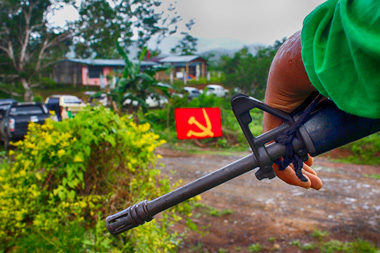by TYRONE A. VELEZ
Davao Today
DAVAO CITY– Davao Oriental Governor Corazon Malanyaon ordered the relocation of residents from more than 10 barangays in five towns who were affected by landslides and sinkholes in the past week.
Malanyaon announced during a a press conference Friday here that Barangay Marayag in Lupon, three barangays in Boston, four in Cateel and an undetermined number of barangays in Baganga and Manay would be declared “no-build zones”, as she ordered local officials to scout for relocation sites.
“Marayag is no longer habitable. In Cateel, San Alfonso and Taytayan were washed out. In Manay, there’s one barangay with 700 families that can’t be reached because the soil sunk,” she told reporters.
She said the diameter of the sinkhole was as long as two coconut trees.
Malanyaon said these areas remained impassable and isolated from relief operations as roads were covered by “debris, soil and boulders.”
She denied earlier reports that cut timber logs from logging operations in the province contributed to the damage.
“I saw them myself, there were debris and huge boulders,” she said.
The governor attributed the landslide due to the province’s weak ground foundation, which she described as “mineralized” similar to that of Compostela Valley’s..
Cateel and other towns such as Boston and Baganga were also devastated by Typhoon Pablo in December 2012.
The Office of Civil Defense Region 11 reported more than 23,000 families were displaced by floods and landslides in Davao Oriental. Most of the towns hit by landslides were located in the province’s east coast facing the Pacific ocean.
Malanyaon said the relocation of residents in these barangays would be done immediately within the coming weeks, and that relocation sites would still be reviewed by the Mines and Geosciences Bureau (MGB) if they do not lie in a hazard-prone area.
“I said no to the barangay officials who were thinking of permitting residents to return to their homes. The relocation is non-negotiable. I’m very strict with respect to no-build zones. This time we can enforce the geo-hazard map of MGB that there are areas that can’t be used for settlement,” she said.
Acquiring lands would be a massive undertaking, citing that one barangay with around 500 to 1,000 households would need a land area of five hectares.
The governor warned landowners who might charge prices higher than the assessed value, adding that she might exercise the local government’s power to expropriate the land.
Malanyaon also appealed to the national government agencies to speed up the process of rebuilding the two collapsed bridges in Baganga and Cateel, stressing that isolation of some towns hamper relief and rehabilitation of infrastructure, including some 1,000 housing units prepared for Pablo survivors.
“The bridges need to be repaired immediately as it connects towns,” Malanyaon said.
Malanyaon also wanted the Department of Environment and Natural Resources to act in disposing felled timber logs in the province, some of which had been wasted and impeding their relief and rehabilitation efforts.
She also asked the agency that the logs could be sold and its proceeds utilized for the livelihood of residents. DENR’s inventory run up to 100 to 500 cubic meters and is said to be worth P5,000 per cubic meter.(Tyrone A. Velez/davaotoday.com)
Baganga Cateel ComVal, Baganga Typhoon Pablo, davao oriental, davao oriental logging, logging Mindanao









